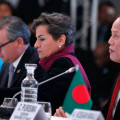Bonn ADP2.10 Wrap
Cécile S | September 10, 2015.
With only five negotiating days away from the decisive climate summit in Paris in December, Parties from 195 countries left Bonn, Germany disappointed about the thin outcomes.
Another week of United Nations climate change negotiations have slowly passed by. Parties commenced the week with concerns and reservations about the co-chair’s tool, which was an attempt to reorganise the Geneva text into an agreement text. Negotiators spent the week in conceptual discussions as they tried to develop bridging proposals at the end of the week.
Unfortunately much of this was done in vain, as the substance that will form the basis of the Paris agreement is still vague.
The week concluded with a mandate to the co-chairs to develop a non-paper, before the October session, that more closely resembles a negotiating text. This will allow for line by line negotiation as opposed to conceptual and procedural discussions that hampered this previous week.
Delegates left Bonn concerned that there were still rumours that the next meeting, scheduled over 19-23 October may be extended, or that an additional negotiation session may be scheduled in November. With only five negotiation days left, and 20 already completed, it is unlikely that more days will further the negotiations.
The Verb provides a run down of the specifics.
Mitigation was considered in several spin-off groups which governments broke into as overall negotiations stalled. In the session about non-market approaches, Bolivia proposed the recognition and establishment of a mechanism for non-market-based approaches. Contrastingly, Venezuela remains staunchly opposed any market mechanism in the new agreement. The European Union suggested the so-called “implementing jointly” approach. Parties also discussed a South African proposal about differentiation, which led to the development of some classification options of differentiation.
On land use, a sub-section of mitigation, the jury is still out with some countries insisting that there should be specific reference in the agreement to REDD+ due to the special circumstances of activities within the sector. Others claim that there is no reason to single out the land use sector and are calling for the inclusion of REDD+ in the finance section.
Discussions within adaptation and loss and damage were generally constructive, and were held in several spin-off groups. This included adaptation finance, global goal and long-term vision. Bridging proposals will be required if compromise text on the global goal on adaptation, adaptation finance and individual country commitments are to be met.
On loss and damage, the group of small island states (SIDS) aligned their position with the group of developing countries (G77) which draws heavily on the least developed country (LDC) proposal to establish a new mechanism, under the new agreement, as well as a displacement facility.
This was one of the few topics in Bonn that saw substantive discussions.
The American position is that a number of issues still need to be resolved. This includes:
- The placement of loss and damage,
- Whether the Warsaw International Mechanism for Loss and Damage (WIM) falls under the agreement or convention,
- How it relates to the convention and if it will be included as part of adaptation or elsewhere, and
- The functions and activities of the relevant institutions.
The US proposal, supported by Australia, the EU and Japan, is to strengthen the Warsaw Mechanism in the COP decision separate to the actual Paris agreement.
It is accepted there should be a compliance mechanism through a facilitative or enforcement-based approach but, this largely relies on how the issues of mitigation and differentiation will be addressed. Developing countries prefer a facilitative mechanism, as they have concerns about their capacity to achieve their mitigation goals.
Some key questions remain around how the compliance mechanism will relate to commitments in the agreement, the relationship between existing compliance mechanisms and a newly established one, and the scope of a new mechanism.
Additionally, there is also a fundamental legal question on the status of the mitigation goals within the intended nationally determined contributions (INDCs). It is currently unclear what aspects of the INDCs will be legally binding and enforceable.
On the general and objective front, the temperature goal and special circumstances—a new form of common but differentiated responsibility (CBDR)—remain within the ‘agreement’ part of the text. This is set to be lined to the mitigation, adaptation and loss and damage aspects of the text.
Numerous breakout groups were held on finance. For the most part, discussions on everything from the scale to sources or commitments and enabling environments were circular. To move these discussions forward, it is important that bridging proposals be put on the table by October.
On enabling environments, the EU agreed with the G77 that enabling environments is a goal and objective of climate finance, not a pre-condition for accessing it. However, the US and Canada said a lack of enabling environments is a barrier to accessing climate finance. Even these two countries have recognised the need to support developing countries.
The G77 is calling for a framework to ensure that public finance will be up-scaled after 2020. They want a periodical review of commitments to ensure predictability, but are yet to come up with quantitative targets. Developed countries insist that enabling environments are key in securing private finance, underlying that needs cannot be met with public finance alone.
There is a general need to add more substance on pre-2020 ambition to the draft decision, which most parties were disappointed in. Financing needs have to be incorporated and significant is still required to reach the US$100 billion commitment that parties have agreed to.
Photo courtesy of the UNFCCC.













comment